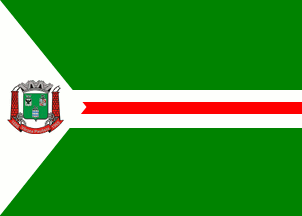 image by
Dirk Schönberger,
22 February 2013
image by
Dirk Schönberger,
22 February 2013 Based on: http://pt.wikipedia.org/wiki/V%E1rzea_Paulista

Last modified: 2013-03-02 by ian macdonald
Keywords: sao paulo | várzea paulista |
Links: FOTW homepage |
search |
disclaimer and copyright |
write us |
mirrors
 image by
Dirk Schönberger,
22 February 2013
image by
Dirk Schönberger,
22 February 2013
Based on:
http://pt.wikipedia.org/wiki/V%E1rzea_Paulista
A green flag with a white-red-white horizontal stripe across the centre, and a white triangle extending from the hoist bearing the municipal arms.
Official website at
http://www.varzeapaulista.sp.gov.br
Dirk Schönberger,
22 February 2013
Várzea Paulista emerged with the inauguration on 1 July 1891 of a railway station on the Santos-Jundiaí line, whose building had been initiated in 1867 by the São Paulo Railway Co. The company built over the tracks a bridge still known as "Ponte Seca" (Dry Bridge). The first settler of the place was Isaac de Souza Galvão, who established a grocery store. The district of Secundino Veiga, name for a noted journalist of the time, was established in 1956, as part of the municipality of Jundiaí, and renamed Várzea in 1960. The municipality of Várzea Paulista was inaugurated on 21 March 1965.
The symbols of Várzea Paulista, designed by Arcinoé Peixoto de Faria, are prescribed by Municipal Law No. 279 of 23 March 1972.
The flag is green with a thin white-red-white horizontal stripe in the middle. A white triangle, charged with the municipal coat of arms, is placed along the hoist. The triangle represents the town as the seat of the municipality. The stripes represent the municipal power. The green fields represent the rural estate, which develop in a good balance with the urban areas.
http://institucional.varzeapaulista.sp.gov.br/index.php?option=com_content&view=article&id=71&Itemid=342 - Municipal website
Photos of the flag
http://www.blogvarzeapaulista.com/news/ministro-aloizio-mercadante-em-varzea-paulista
http://stocker-stockadas.blogspot.fr/2012/06/prestacao-de-contas-iniciado-o-ciclo-de.html
http://blog.cidadedemocratica.org.br/plano-de-desenvolvimento-de-varzea-paulista-e-lancado
http://www.blogvarzeapaulista.com/news/clemente-sabatina-do-conselho-de-saude-na-camara-municipal
http://www.heltonpimenta.com.br/profiles/blogs/varzea-paulista-lula-raniero-a
http://educar.varzeapaulista.sp.gov.br/?p=1177
The coat of arms is made of a green shield. Green is a symbol of honour, civility, courtesy, abundance, peace, friendship, work, prosperity and religious purity The escutcheons placed on the shield are the arms of the Galvão, Souza and Castro family. The first escutcheon, black with an eagle, is a tribute to the founder Issac de Souza Galvão. The second escutcheon, blue with red lions, represents José Souza Constantino. The third escutcheon, blue with a sea horse, immortalizes Eduardo de Castro. Black is a symbol of prudence, knowledge, moderation, austerity and strong-mindedness, Blue is a symbol of justice, nobleness, perseverance, zeal and loyalty. Red is a symbol of patriotic love, dedication, audacity, intrepidity, courage and valiance. The shield is supported by chimneys representing ceramic industry. The gear wheels paced beneath the chimneys represent the business park.
http://institucional.varzeapaulista.sp.gov.br/index.php?option=com_content&view=article&id=71&Itemid=342 - Municipal website
Ivan Sache, 23 February 2013